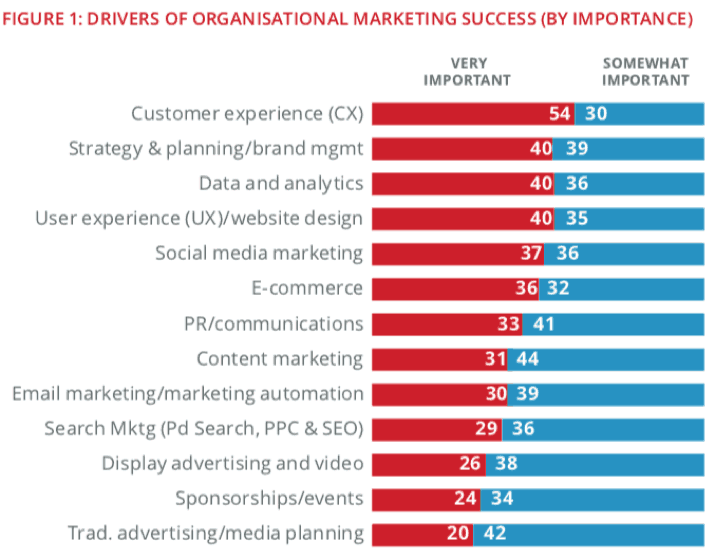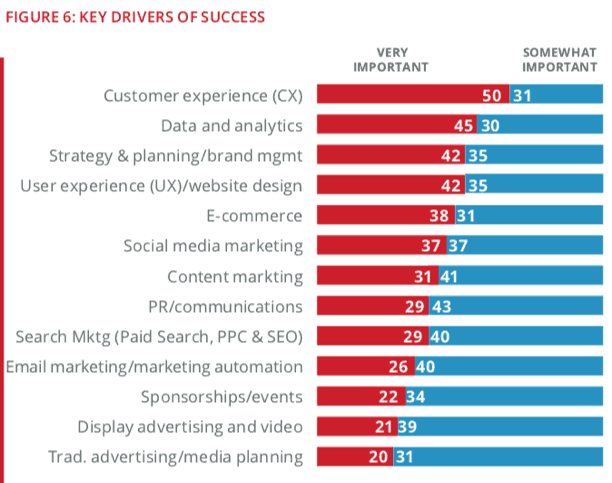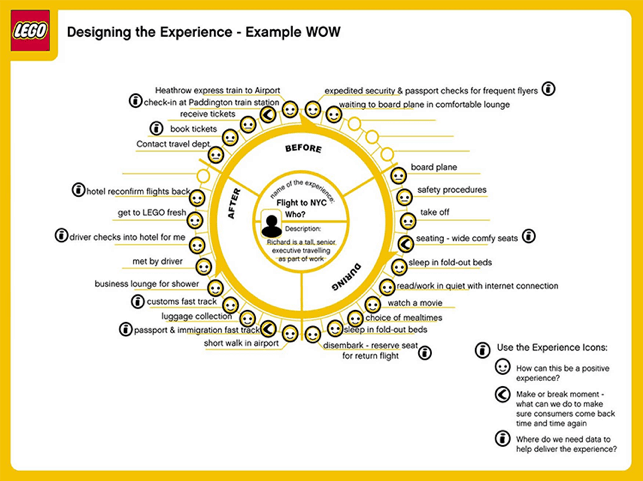
Gone are the days of marketing setting the trends we live by.
Today, the real trendsetters are your neighbors, the people sitting next to you on the train, the guy standing in line for coffee.
According to a new joint report from The Economist Group and Digital Marketing Institute (DMI): When it comes to defining what marketing IS and DOES, customers are now in the driver’s seat.
Unfortunately, this shift in ownership has left many in marketing “behind the curve” when it comes to setting priorities that will help them remain competitive:
“Consumers are setting the agenda for marketers, who are, for various reasons, behind the curve. This position could be the result of an outdated approach, insufficient structure for future-proofing or the talent pool from which they are recruiting. And for both B2C and B2B marketers, not considering the talent and the technology that help to deliver against customer expectations can have a direct impact on the larger business.”
– Perpetual Evolution Report, The Economist and DMI
Based on interviews with over 500 marketing executives, the Perpetual Evolution report looks at the intersection of talent and technology in marketing, and how current and future success criteria are being shaped not by the competition, but by customers.
Below, we’ll look at how these customer-driven trends impact what success looks like in marketing. From there, we’ll dive into steps leaders should take to meet these new challenges head-on.
The Current Vs. Future State Of Marketing
In the report, executives were asked to answer the following question: “To what extent are each of the following areas of marketing important to your organization’s success and business performance today?”
The chart below shows a breakdown of what leaders found to be the most important markers of success in marketing.

Customer experience (CX) topped the list of current success drivers, with 84% of marketing leaders saying that a good customer experience was vital to the success of their organization.
The driving force behind this trend? A buyer capable of interacting with companies whenever, however, and wherever they want. In response, marketers have begun prioritizing campaigns that integrate across multiple channels for their audiences. This push towards digital innovation and brand optimization explains the next two success drivers found in the report: brand management and data analytics.
79% of global executives said that their strategy and brand management initiatives remain the largest drivers of success for their organization.
76% of respondents said that data and analytics are vital to their operations. Microsoft’s CMO even went a step further, identifying the growing role digital transformation has taken in enabling a customer-centric approach to marketing.
“Digital transformation in marketing is key to empower and enable marketers to be more consumer- and customer-obsessed in a competitive landscape, where knowing your customer even more than knowing your competitors is key to sustainable growth.”
– Olivia Kearney, CMO Microsoft (IRE)
Outside of current success drivers, leaders were also asked to rank what success will look like in marketing in the next five years. Surprisingly, there was little difference.
The below chart is almost identical to the “present” success factors noted by marketing leaders earlier. This is by design.

By positioning their teams around future-oriented goals, leaders can better plan for budgets, talent needs and future spend down the line.
For the remainder of this article, we’ll dig into how these success criteria relate to the marketing function and offer best practices for tackling each in your organization.
Customer Experience: The Beating Heart Of Marketing
If you aren’t talking about customer experience and marketing in the same breathe, it’s time to change the narrative.
Customer experience has become more than a buzzword or passing fad. It’s the primary motivation behind almost all other marketing trends mentioned both in this report and those from other leading authorities.
A main takeaway from the Perpetual Evolution report was the need to balance technology and talent to better serve the customer. In the report, 87% of companies said that they need to invest in technologies to help facilitate and improve the customer experience.
However, having a firm strategy on top of that tech is just as important. From discovery to acquisition to renewal, identifying how to improve every stage of the customer lifecycle should be the priority of today’s marketing leaders.
To help you get started, here are a few steps for building your own customer experience strategy:
- Create a clear customer journey map that identifies critical touchpoints and brand channels.

- Determine how you want to measure the experience of customers at these touchpoints (i.e., the metric you want to use, the technology to automate that process, and more).
- Use technology to start relevant conversations across these channels and reduce the need for needless and convoluted touchpoints int the customer journey (i.e., forms).
- Build a closed-loop strategy that includes internal follow-up instructions for employees at the frontline, middle management, and executive level.
- Begin tracking metrics outside of customer satisfaction to better understand how your customer experience program impacts retention, up-sales, cross-sales, referrals, and more.
- Reach out to happy customers and ask if they’d recommend your company. Word of mouth is powerful!
For more information on building your own customer experience strategy, check out our Complete Guide to CX.
Data Analytics: Bridging The Gap Between Tech & Talent
As mentioned earlier, more and more companies are investing in CX-based technologies. As with onboarding any tech, you need the skills in-house to manage and analyze the data to take action. Unfortunately, according to respondents, getting the right technical expertise is difficult at best.
Outside of measuring the drivers of success in marketing, the Perpetual Evolution report also asked executives to explain the challenges faced when executing their objectives.
The number 1 challenge, by an incredible margin, was “securing the right talent.” More than 70% of executives said there was a clear skill deficit in their marketing departments.
What skills did these same marketing leaders report as the most coveted? Those around technology.
And what did leaders say was the hardest area to recruit for? Data and analytics.
What gives with the lack of technically savvy marketers in the workplace? And how can marketing level up their in-house talent or better hire to meet current measures of success? One explanation for the current talent gap within the marketing analytics and ops space is a lack of women encouraged to learn new technical skills. Given that today’s marketing team is made up of more than 60% women, that’s a problem.
In a 2017 survey from the Boston Globe, a majority of those in the marketing profession, across different functional areas, were women.

So how can marketing leaders encourage women to take on marketing ops and data analysis roles in anticipation of this trend?
- Recruiting women
When it comes to recruiting women as new hires in this field, look to organizations catered towards women in technology and marketing. From there, ensure your company is practicing ethical compensation requirements based on criteria like experience and technical prowess.
- Training female employees
87% of respondents said they want to invest in current talent for long-term success. When it comes to leveling up your in-house talent focus on programs that encourage shadowing between female colleagues or work with HR to create a budget around training and certification programs. Create mentorship programs based on marketing functions and get your team comfortable tracking and talking about their own ROI and metrics.
In a broader sense, one of the great struggles reported by leaders in the report was deciding between bringing in new talent or training current employees: 47% of leaders said they will focus more on recruitment for data analytics and technical skills, while 40% indicated that they will balance their needs through both hiring and reskilling.
The report’s authors agree that the best approach is a careful balance between maximizing in-house skills and recruiting for gaps.
Expert of all things marketing ops, Sara McNamara, says employers should focus on recruiting operation professionals who can:
- Hold conversations with leaders about data they want to collect, how they want to collect it, and how to best measure ROI
- Optimize and create marketing tech stacks that are best-in-class
- Practice data cleanliness and reduce redundant technologies
- Work with sales to provide relevant data that improves their sales process
There are also a number of steps marketing heads can take to reskill current talent in this area as well:
- Remember that many marketing technologies are not taught in the classroom. If you’re looking to build operations specialists, focus on honing these skills at the entry-level. (It’s the long play needed to meet your goals five years down the line.)
- Encourage mentorship programs for current teams where more experienced members allow shadowing opportunities.
- Create “Metric Meetings.” At Drift, we have weekly “Monday Metric” meetings with the whole company so people can better understand how we measure our efforts and success. Allow for transparency and questions during this time.
- Invest in your staff by including MarTech certifications as part of their career growth.
Digital innovations have introduced new challenges for managing the customer experience, but also exciting opportunities for those in the marketing field.
Strategy & Brand Management: Future-Focused, Socially Relevant, And Multi-Channel
All respondents of The Economist and DMI’s report are deeply involved in their companies’ marketing strategies. It comes as no surprise then that brand management and strategy are considered key success drivers for these leaders now and in the future.
Looking at data from the report, it’s clear that leaders are best served by building strategies that are future-focused, both at the campaign level and in terms of hiring as well.
However, in a field where staying relevant is a constant challenge, building a strategy that is future-focused is difficult. Here are a few tips to help improve your process:
- Start by looking for ways to track goals at a micro-level. What are each function’s weekly goals? How are you measuring the success of those goals?
- Then have your team coordinate campaigns on both a monthly and quarterly basis. This will help not only align goals across marketing functions, but enable your team to approach their work more strategically.
Brand management, in unison with strategy, has become increasingly important for attracting a new generation of consumers across a growing sea of marketing channels.
While there’s plenty to say in terms of best practices for managing a brand, there are two key issues leaders are looking to tackle:
- Social Issues
Millennials and Gen-X consumers are demanding more of companies when it comes to attaching themselves to social causes. 73% of millennials would be willing to spend more on a product if it is marketed as sustainable. Companies looking to tackle social issues should invest in PR heads to ensure a consistent message across all channels. But a warning: There’s a lot of power in providing a voice to these issues. Ensure you are taking action for causes you want to get behind or the sentiment is moot. Authenticity happens through actions, not words.
- Multi-Channel Execution
From digital advertising to campaign execution, marketing organizations are spending more across a greater amount of channels. Guided by customers-on-the-move and the ease of access to digital platforms, marketers need to remain on high alert for emerging channel popularity among key demographics.
The reason strategy/brand management will remain a success criteria for marketing moving forward has everything to do with relevancy. Is your messaging current, timely and authentic? Are you planning your budget around meeting customers at their convenience?
These questions require leaders to stay plugged into current trends. They also bring us around again, full circle, to the statement we made earlier in this article: Customers are setting the agenda for marketers, not the other way around.
The Next Step: Create A Better Employee Experience To Improve CX
Customers are driving what it means to be successful in marketing.
The importance of data analytics is driven by a more digitally-savvy consumer. The focus on brand management is due to a more socially-conscious and mobile customer. The best way to ensure your marketing organization remains successful five years down the line is to invest in your employees.
Why?
Well, employee experience has a direct correlation to customer experience. In fact, MIT revealed that companies with a highly regarded employee experience have 2X the Net Promoter Score and 25% greater profitability compared to organizations with a dissatisfied workforce. One way to improve your employee experience? Investing in their expertise.







